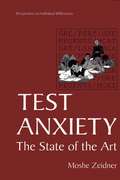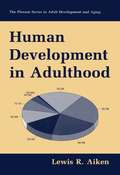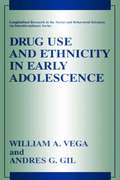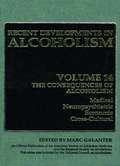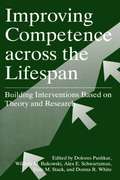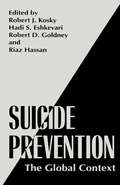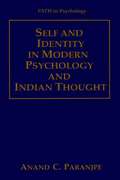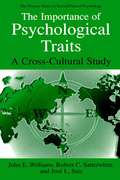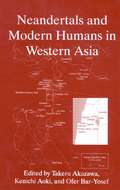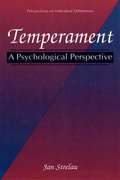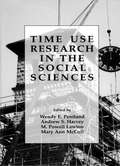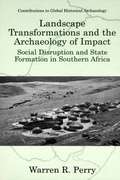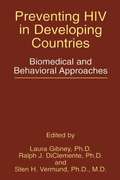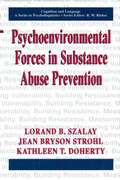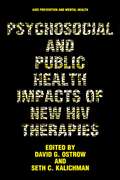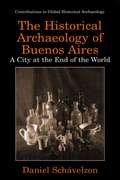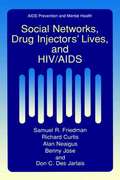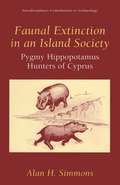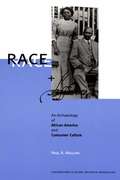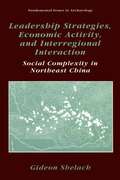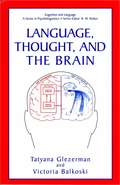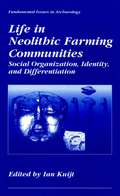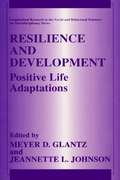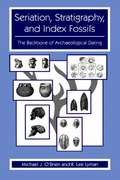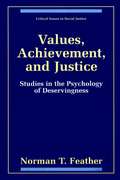- Table View
- List View
Test Anxiety: The State of the Art (Perspectives on Individual Differences)
by Moshe ZeidnerExamination stress and test anxiety are pervasive problems in modern society. As the information age continues to evolve, test scores will become even more important than they are today in evaluating applicants for demanding jobs and candidates for admission into highly competitive educational programs. Because test anxiety gen- ally causes decrements in performance and undermines academic achievement, the development of effective therapeutic interventions for reducing its adverse effects will continue to be an important priority for counselors, psychologists, and educators. Alleviating test anxiety will also serve to counteract the diminished access to edu- tional and occupational opportunities that is frequently experienced by test-anxious individuals. As its title promises, this volume provides a state-of-the-art evaluation of the nature, antecedents, correlates, and consequences of examination stress and test anxiety. Professor Zeidner’s cogent and comprehensive analysis of the affective, cognitive, somatic, and behavioral manifestations of test anxiety are grounded in the extensive knowledge he has gained from his own research on the assessment and treatment of test anxiety. This work has also benefitted from the author’s lo- standing and productive collaboration with leading contributors to test anxiety theory and research, and his active participation in national and international conferences devoted to understanding test anxiety, including those convened by the Society for Test Anxiety Research (STAR).
Human Development in Adulthood (The Springer Series in Adult Development and Aging)
by Lewis R. AikenHuman Development in Adulthood is a comprehensive, multidisciplinary overview of adult development in a number of areas both personal and societal, from mental and physical health, to economic and social conditions. Variables including race, gender, economic status, and political and religious affiliation are considered in the discussion of such human issues as - love and marital relations - economic concerns, including employment and living conditions - violence in its various forms, including crime and war - aging and death. The numerous illustrations, chapter summaries, and glossary will prove especially useful to students.
Drug Use and Ethnicity in Early Adolescence (Longitudinal Research in the Social and Behavioral Sciences: An Interdisciplinary Series)
by William A. Vega Andres G. GilThis book presents new and important information about adolescent drug use. The book is intended for human service professionals, teachers, researchers, and students interested in the issue of early adolescent drug use and its causes and pervasiveness in a multiethnic population. Today, the field of adolescent drug use research relies on integrative models that permit competing explanations of drug use. This approach promotes flexibility in testing hypotheses pertinent to adol- cents of very different social and cultural backgrounds or personal characteristics. Longitudinal studies, including the one presented in these pages, have identified many risk and protective factors or processes that are linked to adolescent drug use. We review these throughout this book and present new information from our own research. Our point of departure is to extend and elaborate descriptive research and models of adolescent drug research to cover the unique and diverse experiences of adolescents who are Hispanic, African American, and White non-Hispanic.
The Consequences of Alcoholism: Medical, Neuropsychiatric, Economic, Cross-Cultural (Recent Developments in Alcoholism #14)
by Marc GalanterFrom the President of the Research Society on Alcoholism On behalf of the Research Society on Alcoholism, I am pleased to introduce this 14th volume of Recent Developments in Alcoholism about the consequences of alcoholism. Current concepts are presented in well-organized sections that focus on the medical, neuropsychiatric, economic, and biobehavioral con- quences of alcoholism. This volume contains up-to-date discussions of these issues. The editors and associate editors should be congratulated for bringing together such important information. This volume will be a valuable resource for investigators and therapists alike. Ivan Diamond M.D., Ph.D. President, Research Society on Alcoholism From the President of the American Society of Addiction Medicine On behalf of the American Society of Addiction Medicine, I am pleased to announce that our society once again will cosponsor Recent Developments in Alcoholism. This volume addresses the issues of age, gender, socioeconomy, and behaviors as they relate to alcohol research and the disease of alcoholism. The medical consequences of alcoholism are ably edited by Dr. Charles L- ber, while the neuropsychiatric consequences of alcoholism are addressed by Drs. Gottheil. This volume is rounded out with the in-depth discussion of the economic consequences of alcoholism, edited by Dr. Fuller, and an inter- tional perspective on the behavioral consequences of alcoholism, edited by Dr. Paredes.
Improving Competence Across the Lifespan: Building Interventions Based on Theory and Research
by Donna R. White Dale M. Stack Alex E. Schwartzman William M. Bukowski DoloresPushkarThis book arises from a conference held in November 1996 designed to examine how competence can be improved in the different stages ofthe lifespan. To this end, we brought together eminent researchers in different areas of human development—infancy, childhood, and adulthood, including the late adult years. The conference was based on the premise that discussion arising from the interfaces of research and practice would increase our knowledge of and stimulate the further application of effective interventions designed to improve competence. The editors wish to acknowledge the contributions of Concordia University and the Fonds pour la Formation de Chercheurs et l’Aide a la Recherche (FCAR) in providing funding and other assistance toward the conference “Improving Competence Across the Lifespan” and toward the publication of this book. Finally, we wish to express our gratitude to the numerous students associated with our Centre for their help and to Gail Pitts and Lesley Husband of the Centre for Research in Human Development for their assistance. We are especially grateful to Donna Craven, Centre for Research in Human Development, for her heroic work on both the conference and the present volume. We could not have met our goals without you.
Suicide Prevention: The Global Context
by Robert J. Kosky Hadi S. Eshkevari Robert D. Goldney Riaz HassanProceedings of the XIXth Congress of the International Association for Suicide Prevention held in Adelaide, Australia, March 23-27, 1997
Self and Identity in Modern Psychology and Indian Thought (Path in Psychology)
by Anand C. ParanjpeEast meets West in this fascinating exploration of conceptions of personal identity in Indian philosophy and modern Euro-American psychology. Author Anand Paranjpe considers these two distinct traditions with regard to historical, disciplinary, and cultural `gaps' in the study of the self, and in the context of such theoretical perspectives as univocalism, relativism, and pluralism. The text includes a comparison of ideas on self as represented by two eminent thinkers-Erik H. Erikson for the Western view, and Advaita Vedanta for the Indian.
The Importance of Psychological Traits: A Cross-Cultural Study (The Springer Series in Social Clinical Psychology)
by John E. Williams Robert C. Satterwhite José L. SaizNeandertals and Modern Humans in Western Asia
by Takeru Akazawa, Kenichi Aoki and Ofer Bar-YosefIn this fascinating volume, the Middle Paleolithic archaeology of the Middle East is brought to the current debate on the origins of modern humans. These collected papers gather the most up-to-date archaeological discoveries of Western Asia - a region that is often overshadowed by African or European findings - but the only region in the world where both Neandertal and early modern human fossils have been found. The collection includes reports on such well known cave sites as Kebara, Hayonim, and Qafzeh, among others. The information and interpretations available here are a must for any serious researcher or student of anthropology or human evolution.
Temperament: A Psychological Perspective (Perspectives on Individual Differences)
by Jan StrelauTemperament is the first monograph in 40 years to present theories and basic findings in the field of temperament from a broad international and interdisciplinary perspective. The text, based on the author's four decades of personal study and data collection, thoroughly explores the physiological, biochemical, and genetic bases of temperament - incorporating age-specific methods of assessment developed through child- and adult-oriented approaches. The 147 illustrations comprise tables of the most popular temperament inventories for both children and adults, and unique data tables illustrating the psychometric features of temperament inventories based on self-rating and rating by others.
Time Use Research in the Social Sciences
by Wendy E. Pentland Andrew S. Harvey M. Powell Lawton Mary Ann McCollThis collection demonstrates the use and variety of applications of time use methodology from multidisciplinary, multinational, and multicultural perspectives. A distinguished roster of contributors from such fields as psychology, occupational therapy, sociology, economics, and architecture examines the complex relationship between human time utilization and health and well-being and evaluates the future of time use analysis as a research tool in the social sciences.
Landscape Transformations and the Archaeology of Impact: Social Disruption and State Formation in Southern Africa (Contributions To Global Historical Archaeology)
by Warren R. PerryAn attempt to use archaeological materials to investigate the colonization of southeastern Africa during the period 1500 to 1900. Perry demonstrates the usefulness of archaeology in bypassing the biases of the ethnohistorical and documentary record and generating a more comprehensive understanding of history. Special attention is paid to the period of state formation in Swaziland and a critique of the `Settler Model', which the author finds to be invalid.
Preventing HIV in Developing Countries: Biomedical and Behavioral Approaches (Aids Prevention and Mental Health)
by Sten H. Vermund Ralph J. Clemente LauraGibneyGlobally, action to prevent HIV spread is inadequate. Over 16,000 new infections occur every day. Yet we are not helpless in the face of disaster, as shown by the rich prevention experience analyzed in this valuable new compendium. “Best pr- tice” exists—a set of tried and tested ways of slowing the spread of HIV, of persuading and enabling people to protect themselves and others from the virus. Individually, features of best practice can be found almost everywhere. The tragedy, on a world scale, is that prevention is spotty, not comprehensive; the measures are not being applied on anywhere near the scale needed, or with the right focus or synergy. The national response may concentrate solely on sex workers, for example. Elsewhere, efforts may go into school education for the young, but ignore the risks and vulnerability of men who have sex with men. Action may be patchy geographically. AIDS prevention may not benefit from adequate commitment from all parts and sectors of society, compromising the sustainability of the response. In some countries matters are still worse—there is still hardly any action at all against AIDS and scarcely any effort to make HIV visible. It is no wonder that the epidemic is still emerging and in some places is altogether out of control.
Psychoenvironmental Forces in Substance Abuse Prevention (Cognition and Language: A Series in Psycholinguistics)
by Lorand B. Szalay Jean Bryson Strohl Kathleen T. DohertyPsychological vulnerabilities and environment influences are the most powerful forces shaping the behavior and choices of students to use harmful substances. This book employs computer-assisted Associative Group Analysis technology of comparative imaging and cognitive mapping to identify these factors and offers new perspectives for more comprehensive risk assessments and effective prevention.
Psychosocial and Public Health Impacts of New HIV Therapies (Aids Prevention and Mental Health)
by David G. Ostrow Seth C. Kalichman“AIDS is kind of like life, just speeded up. ” JavonP. ,heroinaddictwithAIDS, Bronx,NewYork, 1988 “Now I’m not so much scared of dying as scared of living. ” Mike D. , heroin addict with AIDS, New Haven, Connecticut, 1998 Within little more than a decade, AIDS has been tranformed from an untreatable, rapidly fatal illness, into a manageable, chronic disease. Most of this tranformation has occurred in the past five years, accelerated by the advent of protease inhibitors and the proven benefits of combination antiretroviral therapy and prophylaxis against opportunistic infections. For people living with HIV/AIDS, these developments have offered unprecedented hope, and also new challenges. As reflected in the quotes above, some of the anxieties and anticipation of premature dying have been replaced by the uncertainties involved in living with a long-term, unpredictable illness. The role of caregivers for people with HIV/AIDS has also changed radically over this time. Earlier in the epidemic, we learned to accompany patients through illness, to bear witness, to advocate, to address issues of death, dying, and - reavement. The arrival of more effective therapy has brought with it new capabi- ties, but also new complexities, raising difficult problems concerning access to care, adherence, and toxicity.
The Historical Archaeology of Buenos Aires: A City at the End of the World (Contributions To Global Historical Archaeology)
by Daniel SchávelzonA discussion of the historical archaeology of one of the largest cities in the world following four centuries of marginal positioning in regard to empires, trade routes, and the production and accumulation of wealth. The author describes how Buenos Aires came to achieve its current status as a major urban metropolis through an analysis of settlement patterns, architecture, the lifestyle of its residents, and the access to commodities of different social groups.
Social Networks, Drug Injectors’ Lives, and HIV/AIDS (Aids Prevention and Mental Health)
by Samuel R. Friedman Richard Curtis Alan Neaigus Benny Jose Don C. Des JarlaisSocial Networks, Drug Injectors' Lives, and HIV/AIDS recognizes HIV as a socially structured disease - its transmission usually requires intimate contact between individuals - and shows how social networks shape high-risk behaviors and the spread of HIV. The authors recount the groundbreaking use of social network methods, ethnographic direct-observation techniques, and in-depth interviews in their study of a drug-using community in Brooklyn, New York. They provide a detailed documentary of the lives of community members. They describe drug-use, the affects of poverty and homelessness, the acquisition of money and drugs, and social relationships within the group. Social Networks, Drug Injectors' Lives, and HIV/AIDS shows that social networks and contexts are of crucial importance in understanding and fighting the AIDS epidemic. These findings should revitalize prevention efforts and reshape social policy.
Faunal Extinction in an Island Society: Pygmy Hippopotamus Hunters of Cyprus (Interdisciplinary Contributions to Archaeology)
by Alan H. SimmonsThe multidisciplinary research program at Akrotiri Aetokremnos is important, in my op- ion, for three reasons: two empirical and one conceptual. Quite apart from the archaeology, work at the site is a major contribution to island biogeography, in that the Phanourios sample—certainly the best from Cyprus and probably the best anywhere in the world—has already provided, and will continue to provide, important ecological and behavioral data on these intriguing creatures. Dwarfed island faunas are important to our understanding of the complex factors that shape natural selection in ecologically closed environments over the evolutionary long term. At Aetokremnos, we seem to have the “end” of a long sequence of hippo evolution on the island. With comparative studies of other Cypriot hippo faunas, we should be able to pin down the interval of initial colonization by what were, pres- ably, normal-sized hippos, and—if the other sites can be dated—document the dwarfing process in considerable detail. Aetokremnos would still be a significant paleontological - cality, even in the absence of evidence of a human presence there. While reading the text of the monograph, a number of questions strictly related to the paleontology occurred to me. One was how to model the colonization process. There seems to be little question that the large mammals colonized the island by swimming to it (because, I gather, Cyprus has not been connected to the mainland for roughly 5–6 m- lion years).
Race and Affluence: An Archaeology of African America and Consumer Culture (Contributions To Global Historical Archaeology)
by Paul R. MullinsAn archaeological analysis of the centrality of race and racism in American culture. Using a broad range of material, historical, and ethnographic resources from Annapolis, Maryland, during the period 1850 to 1930, the author probes distinctive African-American consumption patterns and examines how those patterns resisted the racist assumptions of the dominant culture while also attempting to demonstrate African-Americans' suitability to full citizenship privileges.
Leadership Strategies, Economic Activity, and Interregional Interaction: Social Complexity in Northeast China (Fundamental Issues in Archaeology)
by Gideon ShelachAn attempt to render Chinese archaeology more accessible to Western readers through a detailed case study of approximately 16,000 years of cultural development in northeastern China. The author addresses prehistoric sociopolitical processes in the Dongbei region through an analysis of both his and other researchers' field data and demonstrates the potential contribution of conducting archaeological research into anthropology-related issues in China.
Language, Thought, and the Brain (Cognition and Language: A Series in Psycholinguistics)
by Tatyana B. GlezermanDrawing on a wide variety of modern and classical sources and multiple disciplines, this book presents hypothesizes about the relationship between human language and thought to brain specialization. The authors focus on aphasia-language disorder resulting from local brain damage and show that the clinical aspect represents not only loss of function of the damaged area, but also results from the interaction between damaged and intact areas of the brain.
Life in Neolithic Farming Communities: Social Organization, Identity, and Differentiation (Fundamental Issues in Archaeology)
by Ian KuijtDrawing on both the results of recent archaeological research and anthropological theory, leading experts synthesize current thinking on the nature of and variation within Neolithic social arrangements. The authors analyze archaeological data within a range of methodological and theoretical perspectives to reconstruct key aspects of ritual practices, labor organization, and collective social identity at the scale of the household, community, and region.
Resilience and Development: Positive Life Adaptations (Longitudinal Research in the Social and Behavioral Sciences: An Interdisciplinary Series)
by Meyer D. Glantz Jeannette L. JohnsonLeading experts review the research on resilience and represent the diverse perspectives and opinions found among both scientists and practitioners in the field. Although the chapters are written to the standards expected by researchers, they are equally useful for program developers and others in applied fields seeking science-based information on the topic. This book is a unique resource in keeping with the growing interest in resilience both in research and interventions.
Seriation, Stratigraphy, and Index Fossils: The Backbone of Archaeological Dating
by Michael J. O'Brien R. Lee LymanIt is difficult for today's students of archaeology to imagine an era when chronometric dating methods were unavailable. However, even a casual perusal of the large body of literature that arose during the first half of the twentieth century reveals a battery of clever methods used to determine the relative ages of archaeological phenomena, often with considerable precision. Stratigraphic excavation is perhaps the best known of the various relative-dating methods used by prehistorians. Although there are several techniques of using artifacts from superposed strata to measure time, these are rarely if ever differentiated. Rather, common practice is to categorize them under the heading `stratigraphic excavation'. This text distinguishes among the several techniques and argues that stratigraphic excavation tends to result in discontinuous measures of time - a point little appreciated by modern archaeologists. Although not as well known as stratigraphic excavation, two other methods of relative dating have figured important in Americanist archaeology: seriation and the use of index fossils. The latter (like stratigraphic excavation) measures time discontinuously, while the former - in various guises - measures time continuously. Perhaps no other method used in archaeology is as misunderstood as seriation, and the authors provide detailed descriptions and examples of each of its three different techniques. Each method and technique of relative dating is placed in historical perspective, with particular focus on developments in North America, an approach that allows a more complete understanding of the methods described, both in terms of analytical technique and disciplinary history. This text will appeal to all archaeologists, from graduate students to seasoned professionals, who want to learn more about the backbone of archaeological dating.
Values, Achievement, and Justice: Studies in the Psychology of Deservingness (Critical Issues in Social Justice)
by Norman T. FeatherWhen we say that a person deserves a positive or negative outcome, we are making a judgment that is influenced by a number ofvariables. We would certainly take into account whether the person was resp- siblefortheoutcomeorwhethertheoutcomecouldbeattributedtoother sources. We would also consider whether the actions that led to the positive or negative outcome were actions that we would value or - tionsthatwouldmeetwithourdisapproval.Wemightalsobeinfluenced by the person’s own positive or negative characteristics, by ourkno- edgeofwhatkinds ofgroups orsocialcategoriesthepersonbelongedto, and by whether we like or dislike the person. Information about these differentvariableshastobe consideredandintegratedin someway, and our judgment of deservingness follows that psychological process, a process that involves the cognitive-affective system. Values, Achievements, and Justice is about deservingness and about the variables that affect the judgments we make. I use the term “dese- ingness” although I could equally have referred to “deservedness” or “desert.” The terms are all virtually equivalent in meaning, although dictionaries may separate them by using fine distinctions. I assume that the sorts of variables I have just described will affect ourjudgments of deservingness, and I further assume that a judgment of deservingness is most likely to occur when these variables fit together in a consistent, harmonious, and balanced way.
